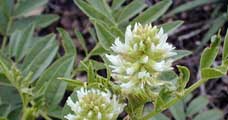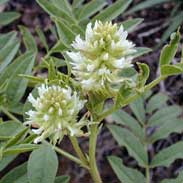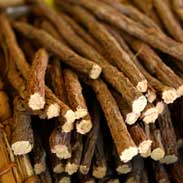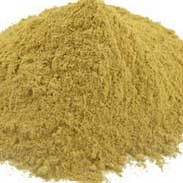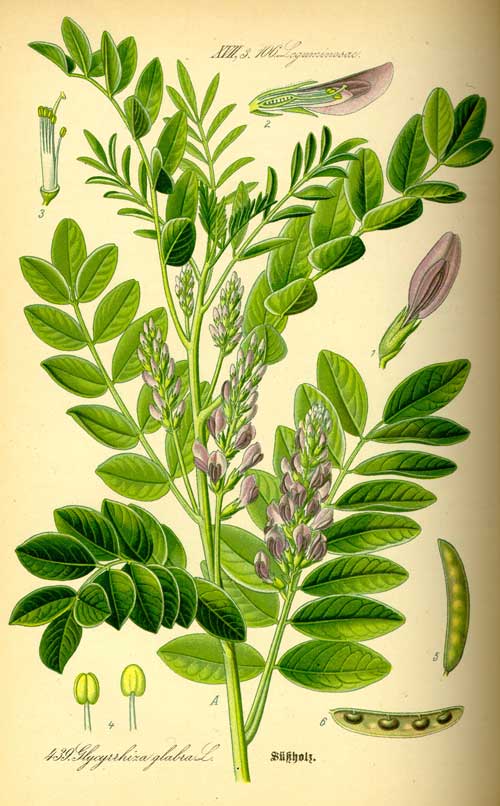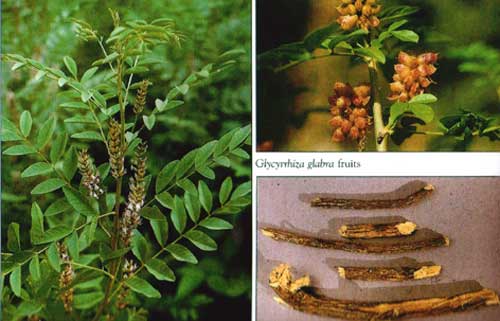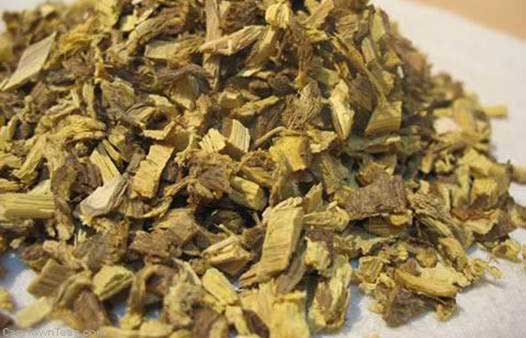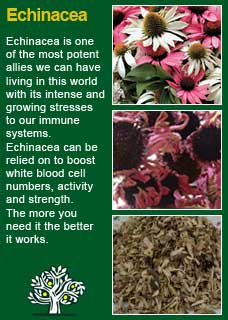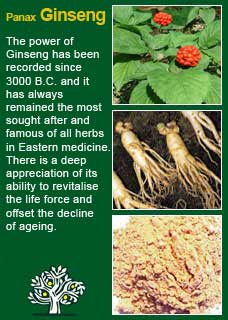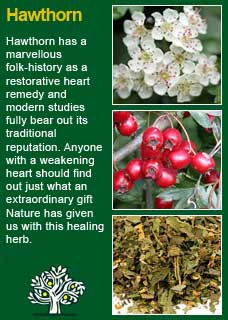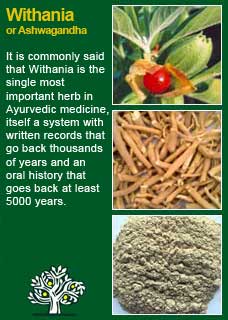
|
|
||||
| Our Pages ABOUT CONSTITUTIONAL MEDICINE
|
In herbal medicine we use the dried roots of Licorice, a graceful, long lived plant that grows to about one meter in warm climates. Licorice spreads its lance shaped leaves out during the day to catch the sun and then lets them hang down at night to rest. The roots of Licorice are brown, long and cylinder shaped. They have lengthwise corky fibres, are coloured from white to yellow and are profoundly sweet to taste.
Medicinal Licorice has been used for many centuries as an agent to soothe, heal and tonify. It is probably the most important herbal medicine for ulcers of the mouth, stomach or duodenum and it is hard to imagine a herbal cough medicine without at least some Licorice in it. Licorice features prominently in the first great Chinese herbal, the Pen Tsao Ching (Classic of Herbs) and Chinese medicine has used Licorice as a remedy for strength and long life for thousands of years. Today it is still found in most Chinese formulas, in large part because it is seen as the ‘ambassador’, the herb that helps the other herbs to harmonise with each other and within the body. Licorice was carried by the armies of Alexander the Great to allay thirst and provide endurance. It was similarly carried by Roman soldiers all over Europe. German abbess/herbalist St Hildegard of Bingen prescribed Licorice for stomach and heart problems and it was frequently mentioned in German and Italian herbals from the 14th and 15th century as a cough and respiratory remedy. Nicolas Culpeper wrote 'Licorice is a fine medicine, for those that have a dry cough or hoarseness, wheezing or shortness of breath, phthisis (tuberculosis), heat of urine and griefs of the lungs'. Sharol Tilgner writes 'Licorice is most known for its soothing effect on inflamed mucous membranes of the throat, lungs, stomach & intestines. The root is used for coughs, all throat and bronchial irritations, urinary tract irritation, adrenal fatigue, immune deficient states, allergies, gastric & duodenal ulcers, liver disorders, exhaustion due to adrenal stress and dermatological detoxification. It is effective for chronic hepatitis, useful in HIV and is specific for conditions like mononucleosis (Glandular fever), where the patient has abnormally high liver enzymes, a sore throat and needs immune system support. It is a wonderful herb for the chronic fatigue syndrome and due to its sweet taste, Licorice makes a nice addition to formulas that are unpalatable' Thomas Bartram writes that Licorice's actions are 'demulcent, expectorant, glycogen-conserver, anti-inflammatory, adrenal restorative, (having glycosides remarkably similar to the body steroids), regulates salt & water metabolism, anti-stress, anti-ulcer, antiviral, liver protective & anti-depressive. Bartram suggests it may be used for adrenal insufficiency, sodium retention properties useful for Addison's disease, hypoglycaemia, peptic ulcer, inflamed stomach, mouth ulcer, duodenal ulcer, respiratory infections, dry cough, hoarseness, bronchitis & lung troubles. Bartram suggests doses of 1-5 grams up to 3 times daily. Half to one tsp of the dried herb simmered in decoction for 15 minutes or 2-5mls of the liquid extract. The British Herbal Pharmacopoeia (BHP) describes Licorice's actions as expectorant, demulcent, spasmolytic, anti-inflammatory, adrenal agent & mild laxative and says it is indicated for bronchial catarrh, bronchitis, chronic gastritis, peptic ulcer, colic & primary adrenocortical insufficiency and specifically indicated for gastric or duodenal ulcer & Addison's disease. The BHP suggests a dose of 1-4 gms or by decoction and recommends 2-5mls of the liquid extract up to 3 x daily.
~ There have been numerous clinical and laboratory studies into Licorice, the majority of them focusing on a substance called glycyrrhizin that is about 50 times sweeter than sugar and has a powerful cortisone-type action in the body. ~ In recent decades an increase in understanding licorice, both how it works and what it does, has seen it being recommended for people that are recovering from overuse of steroids. Licorice has ingredients in it called steroidal saponins that appear to be able to nourish adrenal glands back to health, effectively helping our bodies to rebuild our own production of steroidal hormones (Whorwood CB, Sheppard MC, Stewart PM, Endocrinology 1993; 132(6):2287-2292) ~ Back in 1946 a Dutch pharmacist noticed that licorice candies and cough remedies were unusually popular in patients who had gastro-intestinal ulcers. They told him that the Licorice gave them better and longer lasting relief than the actual ulcer medications they had tried. Intrigued he published a report since which Licorice has been the subject of a number of clinical trials which have shown to it to a highly effective medicine for peptic, gastric and duodenal ulcers, so long as it used wisely (Morgan AG, McAdam WA, Pacsoo C et al. Gut 1982; 23(6):545-551) ~ For mouth ulcers (canker sores) clinical research suggests that gargling with warm water containing deglycyrrhizinated licorice powder 200 mg four times daily for 7 days improves pain in 75% of patients by day one and results in complete healing in 75% of patients by day three (Das SK, Das V, Gulati AK, and et al. Deglycyrrhizinated liquorice in aphthous ulcers. J Assoc Physicians India 1989;37(10):647) Licorice extract in quite high doses demonstrated a dramatic effect in maintaining electrolyte balance in patients with Addison's disease. (Borst JGG de Vries LA, Holt SP et al. Lancet 1953; 657-663). Licorice extract may also be of benefit in the treatment of Parkinsons disease and Graves disease although this has not been scientifically investigated so this recommendation is based on anecdotal evidence of benefit. ~ An ointment containing Licorice extract showed good results in treating chronic eczema and the steroidal type nature of glycchizin means that it has been likewise widely used for inflammatory joint conditions such as arthritis (Loewy E. Ars Medici 1956;46(1):483) ~ Licorice root in reasonably modest doses (approx 1 gram a day or 2 mls of a 1:2 fluid extract) significantly reduced the severity and number of hot flushes in menopausal women (Nahidi F, Zare E, Mojab F, Alavi-Majd H. Effects of licorice on relief and recurrence of menopausal hot flashes. Iran J Pharm Res 2012;11(2):541-8) ~ For patients with non-alcoholic fatty liver disease, clinical research has shown that taking licorice root extract 2 grams daily for 2 months reduces levels of alanine aminotransferase (ALT) and aspartate aminotransferase (AST) compared to baseline (Hajiaghamohammadi, A. A., Ziaee, A., and Samimi, R. The efficacy of licorice root extract in decreasing transaminase activities in non-alcoholic fatty liver disease: a randomized controlled clinical trial. Phytother Res 2012;26(9):1381-1384) ~ For cholesterol, clinical research suggests that taking licorice root extract 0.1 grams daily for one month reduces plasma total cholesterol levels by 5%, plasma low-density lipoprotein (LDL) cholesterol levels by 9%, and plasma triglyceride levels by 14% compared with baseline in patients with moderate hypercholesterolemia (Fuhrman, B., Volkova, N., Kaplan, M., Presser, D., Attias, J., Hayek, T., and Aviram, M. Antiatherosclerotic effects of licorice extract supplementation on hypercholesterolemic patients: increased resistance of LDL to atherogenic modifications, reduced plasma lipid levels, and decreased systolic blood pressure. Nutrition 2002;18(3):268-273) ~ In human research, consumption of a licorice herbal tincture stimulated immune cells, as quantified by CD69 expression on CD4 and CD8 T cells (Brush, J., Mendenhall, E., Guggenheim, A., Chan, T., Connelly, E., Soumyanath, A., Buresh, R., Barrett, R., and Zwickey, H. The effect of Echinacea purpurea, Astragalus membranaceus and Glycyrrhiza glabra on CD69 expression and immune cell activation in humans. Phytother Res 2006;20(8):687-695) ~ Licorice stimulates the body's own natural anti-viral compound interferon and a study published in Microbiology and Immunology showed that it made a significant positive difference to the treatment of the common infection Herpes simplex. Numerous other laboratory studies have shown that Licorice helps fight disease causing bacteria and fungi (Csonka GW, Tyrell DA. Br J Ven Dis 1984; 60(3):178-181) ~ The authors, titles and the 'where-and-when' published of well over 200 further studies and articles on Licorice are listed in a PDF found here
'Use with care' is largely a matter of simply not taking too much of it! The World Health Organisation (WHO) recommends a safe daily dose of Licorice to be between 5 and 20grams of Licorice root a day (equivalent to 200-800mg of glycrrhizin) but this is already much higher than the amounts we typically use in herbal medicine, even in quite robust treatment programs, which at the higher end equate to not more than 3 or 4 grams a day of the dried herb in a concentrated liquid form, often considerably less than that when using Licorice within a formula of other herbs. Most people will need to take between 20 to 30 grams a day before they are at risk of side effects from Licorice. That said, a person with high blood pressure, impaired kidney function and/or who had a high salt diet could potentially get some adverse responses to Licorice with as little as 5 grams a day. All that said, for some people it can be seen that even small amounts of Licorice will increase their blood pressure and, if a person has a history of high blood pressure, then I will be unlikely to use Licorice root just in case it could do some harm. However, if there were some compelling reasons to use Licorice (e.g. a bad cough, an inflamed stomach) then I would still be willing to take a 'try and see' approach whilst carefully monitoring their blood pressure or whether they began to retain fluid. This can be done safely with home blood-pressure monitors and some education about the plant. Taking Licorice root at the same time as using steroidal drugs (e.g, predisone, cortisone) is likely to increase the blood levels of the drugs and lengthen the time that they are active in the body as seen in a number of case studies (Armanini D, Lewicka S, Pratesi C, et al. Further studies on the mechanism of the mineralocorticoid action of licorice in humans. J Endocrinol Invest 1996;19:624-9) (Chen MF, Shimada F, Kato H, Yano S, Kanaoka M. Effect of glycyrrhizin on the pharmacokinetics of prednisolone following low dosage of prednisolone hemisuccinate. Endocrinol Jpn 1990;37:331-41) Using substantial doses of Licorice with a person who is using drugs that contain cardiac glycosides could increase the risk of hypokalemia (low potassium levels), likewise for a person who is taking diuretics such as chlorothiazide (Diuril), chlorthalidone (Thalitone), furosemide (Lasix), hydrochlorothiazide (HCTZ, HydroDIURIL, Microzide). Licorice seems to increase metabolism and decrease levels of warfarin in animal models. This is likely due to induction of cytochrome P450 2C9 (CYP2C9) metabolism by licorice.
For some years now, against this proven and safe way of herbalism, there has been a rising tide of excessive caution and scare-mongering in many parts of the world. The same authorities that, not so long ago, decried herbal medicines as ineffectual, have now taken up a different adversarial position; that they are dangerous substances that should only be prescribed by Doctors, who of course have zero training in them. Unfortunately, the same unnecessary fear and worry has crept into many natural health websites and popular publications on herbs. Herbs that we have safely used for thousands of years, that have no reports of adverse reactions in the medical literature despite widespread use by millions of people, are suddenly described as contraindicated because of something that should have been seen as completely unimportant, or at the utmost a merely theoretical concern, such as a laboratory study on one of the herb's constituents to use an all too common example. I wonder sometimes if the writers of such articles feel that the herb will be more deserving of respect if it is thought to be a little bit dangerous, in other words more like a drug than something that has simply come out of the earth and been used by ordinary people for generations beyond count. There is just so much misinformation about herbal medicine on the internet now. Ludicrous claims and cautions abound in equal measure; it seems like one group are trying to make money out of the public whilst the other are busily trying to scare them off. I have to believe that the kind of reader who takes the time to read pages on herbs that are as extensive as this one is much less likely to be swayed by marketers or misinformers. I hope that you will keep your wits about you if you get conflicting opinions from people who have never really got to know these herbs, who have never worked with them, or learned how to use them safely and effectively. I want to remind you that the reason that herbs can never be patented and owned by any individual or corporation is because they are, and always will be, the People's medicine. They belong to all of us and it is my great hope in sharing this work that you will learn how to use them wisely for yourself, and the people you care for. Be safe, but do not be afraid.
I use a very great deal of Licorice in my work. This is at least in part because formulas will often work better when there is a little bit of Licorice in them. You could say that this is simply because people tolerate the taste better and you won't be wrong, but there is more to this than just that... There is something about Licorice that helps other herbs to blend together in the body and get to where they need to go. The Chinese appreciation of it as the 'Ambassador' herb is not just a whimsical folk-tale. You can feel how it has a harmoning effect in the formula and you can see it in action when you make a mixture in a glass cylinder and then add the Licorice last whereby all the other herbs suddenly blend together. My primary use for Licorice is as a harmonising herb in formula but I also very much like it as a tonic for the adrenals and the immune system and as a gently cleansing, soothing, healing herb for the gut and the respiratory system. If you who are reading this are studying herbal medicine or if you just want to understand this great plant ally at a much deeper level for your own reasons then I warmly encourage you to undergo the ancient way of learning the 'action' of Licorice by taking a small dose of it and then, with a quiet and attentive mind, observing how it feels within your body. Doing this for myself and also with my family and many others I see that Licorice actually has a calming effect. I have often given just a few drops of Licorice extract to my children when they are agitated and upset, and the relaxing action is almost immediate. If you do this experiment I think you will be able to feel for yourself how the action of Licorice goes all the way to the centre of our stress responses; our adrenals, and that the experiential understanding of that will give you a very practical rationale for why it helps so many people who are working through the stress that comes with being unwell. Further to this, if you would like to learn more about the ancient art of pulse testing, a simple but powerful way to ask the intuitive intelligence of the body for its responses to a herb by feeling the pulse whilst giving a tiny dose by mouth, read here Licorice has a whole-body tonic effect, the immune system, the energy levels, the nerves, the digestion, the liver function, all improve, often significantly, with a little bit of Licorice root extract every day. Someone taking Licorice as a herb for the first time should know that it does tend to have a gentle cleansing action on the liver and consequently, whilst it is not a laxative, people often notice increased elimination when they take Licorice extracts. Licorice combines perfectly with many herbs, just a few examples include Echinacea, Ginseng, Hawthorn or Withania to make strengthening tonics for the immune system, the heart, the adrenal glands and the nerves.
Much of the information here about the traditional uses of Licorice is consistent with the model of thinking whereby one may treat problem A with plant B. There is value in this approach, especially in how it helps us pass on useful knowledge to one another, but it falls short in one vital area; and that is that people are not all cut from the same cloth! Something that works brilliantly for one person may do less for another -- why is this? Part of the reason is that people vary in their constitutions as to whether they are either hotter or cooler and, at the same time, either dryer or damper. This useful and rather fascinating subject is introduced further here Another big part of using the right herb when it is most needed comes from understanding the need to treat what is going wrong for the person that had led up to their getting a health condition. In this light, Licorice can particularly offer its benefits when a nourishing action is needed in the 'cycle of healing', more about this here
Please understand that I cannot advise you, including on products or dosage, without seeing you in person in my clinic but for ideas
on how you might find a good herbalist in your area read here |
|
|
© 2011 R.J.Whelan Ltd
